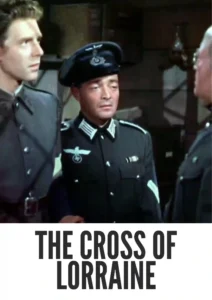Video Sources 0 Views

Synopsis

Immerse yourself in the heart of wartime France with Cross of Lorraine, a powerful drama from 1943, now beautifully colorized to bring its poignant story to life. This film vividly portrays the struggles and sacrifices of the French Resistance during World War II. Perfect for history buffs and fans of classic war movies, this HD download offers a compelling and emotional journey. Originally released under the title The Cross of Lorraine, this film remains a testament to the resilience of the human spirit in the face of oppression.
Cross of Lorraine tells the gripping story of French soldiers held in a German prisoner-of-war camp who are gradually won over to the cause of fighting for freedom. The narrative centers around Paul Dupré (Jean-Pierre Aumont), a young French soldier initially apolitical and demoralized by the Nazi occupation.As Paul witnesses the brutality and injustice of the German regime, he begins to understand the importance of resistance. He is influenced by the unwavering spirit of his fellow prisoners, particularly a priest who inspires them to maintain their faith and dignity. Paul’s transformation is the emotional core of the film, depicting his journey from a reluctant captive to a courageous fighter.The film follows Paul and his comrades as they plan their escape and join the French Resistance. They face immense challenges, including betrayal, capture, and the constant threat of death. Through their courage and determination, they embody the spirit of the French people’s struggle against Nazi oppression. Cross of Lorraine is a moving tribute to the heroes who risked their lives to liberate their country, showcasing themes of hope, sacrifice, and the enduring power of the human spirit.
The film features a stellar cast of actors who deliver powerful performances:
- Jean-Pierre Aumont as Paul Dupré
- Gene Kelly as Victor
- Marlon Brando as an uncredited German soldier
- Cedric Hardwicke as Father Sebastien
- Peter Lorre as Sergeant Berger
Cross of Lorraine is a wartime drama, blending elements of action, suspense, and profound emotional depth. Its historical setting and themes of resistance and sacrifice make it a powerful and thought-provoking film.
Released in 1943, Cross of Lorraine was produced during a time when Hollywood was actively contributing to the war effort. The film reflects the prevailing sentiments of support for the Allied forces and admiration for the French Resistance. It aimed to inspire audiences with stories of courage and resilience in the face of tyranny. While not always entirely accurate in its historical depictions, Cross of Lorraine captures the essence of the French Resistance movement and the spirit of the time. It stands as a reminder of the sacrifices made by countless individuals during World War II and the importance of standing up against oppression.
This colorized version of Cross of Lorraine has been meticulously restored using state-of-the-art digital techniques, enhancing the visual impact while preserving the film’s original emotional intensity. The colorization process involved a detailed analysis of the original black and white footage, with careful attention to historical accuracy and artistic integrity. Advanced algorithms were used to select appropriate color palettes, enhance image details, and create a seamless viewing experience. This painstaking process brings new vibrancy to the characters and settings, making the story even more accessible and engaging for contemporary audiences. While debates about colorizing classic films continue, this version seeks to honor the film’s legacy while introducing it to a wider audience.
- : Tay Garnett
- : Michael Kanin, Ring Lardner Jr., Alexander Esway, Robert Lewin
- : the novel A Thousand Shall Fall by Hans Habe
- : Sidney Wagner
- : Albert Akst
- : Metro-Goldwyn-Mayer
- : Metro-Goldwyn-Mayer
- : 90 minutes
- : MP4
- : HD (1080p)
- : Compatible with most devices, including smartphones, tablets, computers, and smart TVs.
Cross of Lorraine (1943) was generally well-received upon its release, praised for its powerful performances and moving portrayal of the French Resistance. While some critics noted its somewhat idealized depiction of the resistance movement, the film was widely appreciated for its emotional impact and its message of hope and resilience. Today, Cross of Lorraine remains a significant example of wartime Hollywood cinema and a tribute to the courage of those who fought for freedom.
- : What is Cross of Lorraine about?
- A: Cross of Lorraine is a wartime drama about French soldiers in a German prison camp who join the French Resistance.
- : Is Cross of Lorraine (1943) a historically accurate film?
- A: While the film captures the spirit of the French Resistance, it may not be entirely accurate in its historical depictions.
- : Is this version of Cross of Lorraine colorized?
- A: Yes, this version has been professionally colorized to enhance the viewing experience.
- : What makes Cross of Lorraine interesting for war movie fans?
- A: Cross of Lorraine offers a compelling and emotional portrayal of the French Resistance during World War II.
- : What is the download format?
- A: The download format is MP4, which is compatible with most devices.
- : What resolution is the download?
- A: The resolution is HD (1080p), providing a high-quality viewing experience.
Watch Cross of Lorraine Today!











